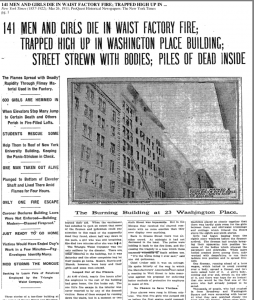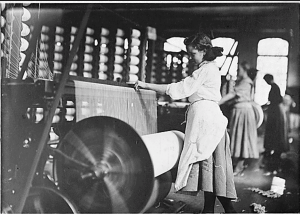Women
Triangle Shirtwaist Fire
Women suffered grave consequences as a result of the rise of big business.

Many people were actually harmed in the making of big business, for it led to horrid factory conditions in urban areas. In 1911, an article was published in the New York Times documenting the Triangle Shirtwaist Fire, an awful fire that killed 141 people. This fire only took place because of terrible working conditions for garment workers. This document was written for an audience of people who had not yet heard about this fire, and it intended to inform people that this is how the. large corporations that practically ran the nation were treating their workers. The article details that there was only one fire escape in the entire building making it next to impossible for the garment workers to escape. This shows that in many cases, the rise of big business was not beneficial. If the triangle shirtwaist company had followed regulations, this could have been prevented. Yet more often than not, tragedies like these occurred as a direct effect of the rise of these companies. This source was found through a proquest search.
Nell Cusack, “City Slave Girls”
In 1888, Nell Cusack set out to publish a series of investigative articles about the poor working conditions women faced in Chicago’s factories. His research focused on women working in garment factories, in particular. The article examined for this exhibit focused on a woman the reporters found fast asleep and very ill in one of the factory bathrooms. She spoke to the people who found her, of the horrid factory conditions she had suffered through in three separate factories she had worked in in the six months she had lived in the country. She also spoke of how on most days she would make less than a single dollar. The article detailed that the girl was paid five cents to make a jersey that was then sold for two dollars. This source examines the wealth inequalities across the nation. The purpose of this series of articles was to alert the nation of the atrocities women were experiencing in factories across the nation.
Farmers

In 1944, Alston Waring and Walter Maqnes Teller published an article in a magazine that was published in New York, NY. This article showcased famers feelings on the growing industrial businesses. They felt hurt and underrepresented in their fields due to the US growing away from needing farmers. Their purpose for writing this was to get the attention of people who may be unaware that increasing technologies could be damaging their fields. This shows that by this point in time, business was rising at such a rapid rate, farmers, who had been the backbone of society for years, were starting to no longer be needed. They acknowledge that the growth of monopolies are a large factor in hurting the farming industry because farms cannot be monopolized. The main points these farmers are trying to make is that they believed that World War II would help transform their field but they are feeling as underrepresented as they were before the war. This article was found through a proquest search.
Children

Lewis Hine took this photo in October 1908 in Evansville, Indiana. This was a part of his journey to expose the dangers of child labor. He believed that child labor doomed children to a life of poverty and illiteracy. This photo depicts a girl working at a weaving machine. It can easily be seen that the girl is operating a machine that is way bigger than she is. It can be inferred that this machine is highly dangerous and the girl is way too young to be working such machinery. Hine took this image to expose large corporations and their greed in employing such young children. It also shows how there is a large amount of wealth inequality in the nation because parents are forced to put their children in these highly dangerous situations, just for a tiny amount of income. This photo is currently stored in the national archives.
How the Other Half Lives

Jacob Riis wrote his famous book, “How the Other Half Lives” in 1890. This book was written to expose how the impoverished people of New York lived. The above photo is titled “Five-Cent Spot” and is currently displayed at the Museum of the City of New York. It shows a family living in an extremely dirty and crowded room. Looking at their living conditions shows a viewer how impoverished this family was. This room in particular charged five cents a night to stay in for the family. Riis took this photo to show people how the government allowed its’ impoverished people to live. He was successful within this, for, his images sparked a lot of public outcry. This image was found on the Library of Congress website.
Philanthropy

The Gospel of Wealth is an article written and published by robber Barron Andrew Carnegie in June 1889 and originally published in the North American Review. This source is unique and unlike other sources in this exhibition, for it shows one of the rare, good effects of the growth of business. In Carnegie’s article, he details how crucial he believes it is to use obtained wealth to give back to the underprivileged. It was rare, that as an owner of a monopolistic company, that he acknowledged the, as he calls it, “administration of wealth”, was extremely lacking. Although this counters some of the arguments this exhibition makes, it shows that there were so many problems with the distribution of wealth that some of the good hearted business owners recognized it. This source was found on Carnegie.org.
